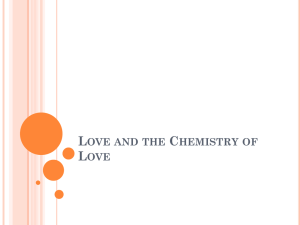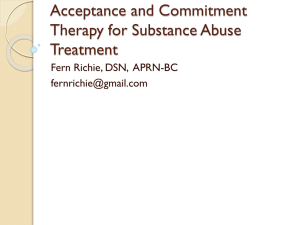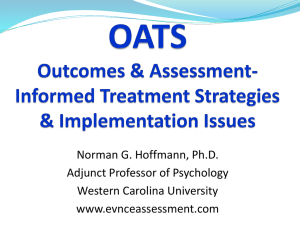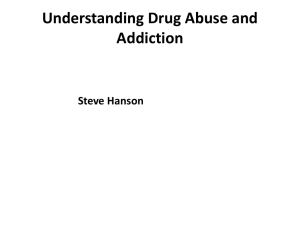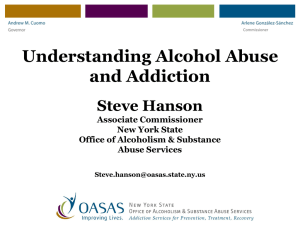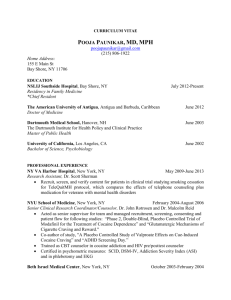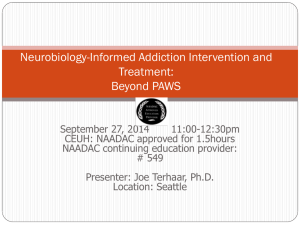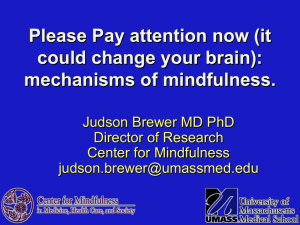Classification of Anticraving Techniques
advertisement
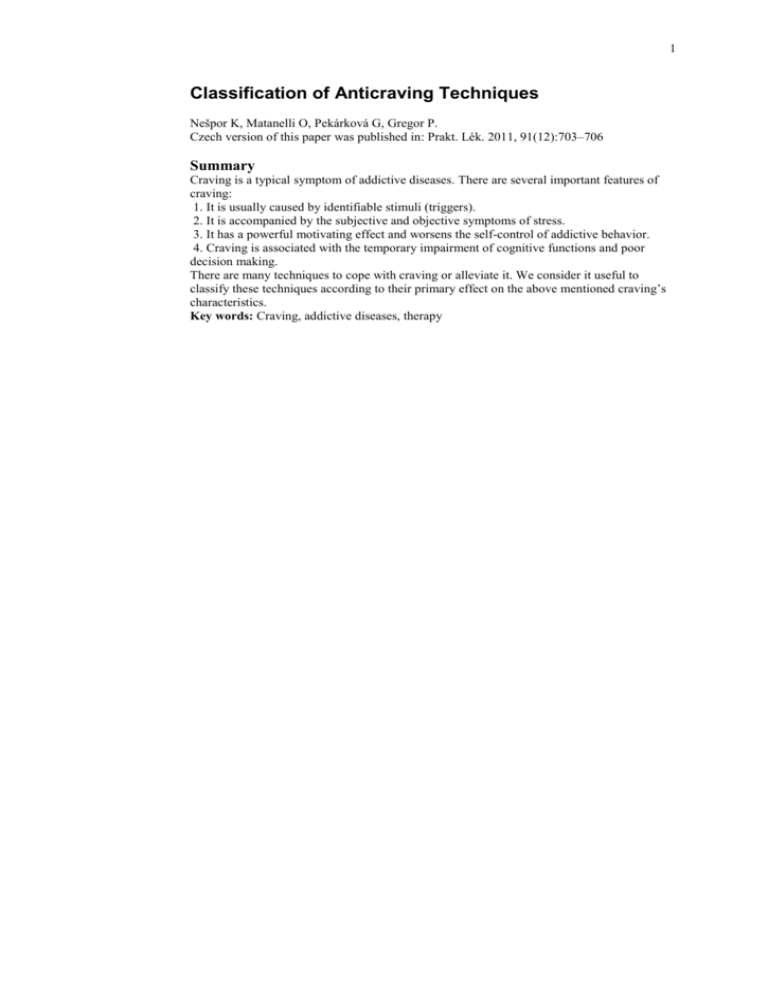
1 Classification of Anticraving Techniques Nešpor K, Matanelli O, Pekárková G, Gregor P. Czech version of this paper was published in: Prakt. Lék. 2011, 91(12):703–706 Summary Craving is a typical symptom of addictive diseases. There are several important features of craving: 1. It is usually caused by identifiable stimuli (triggers). 2. It is accompanied by the subjective and objective symptoms of stress. 3. It has a powerful motivating effect and worsens the self-control of addictive behavior. 4. Craving is associated with the temporary impairment of cognitive functions and poor decision making. There are many techniques to cope with craving or alleviate it. We consider it useful to classify these techniques according to their primary effect on the above mentioned craving’s characteristics. Key words: Craving, addictive diseases, therapy 2 Introduction Craving is one of the key symptoms of all addictive diseases. It occurs in substance dependence, pathological gambling, and it is even mentioned in connection with eating. It is therefore a phenomenon of great practical importance. We deal in this paper with mental craving which is not related to withdrawal syndromes. Field et al. (3) considered attraction as typical for craving, as opposed to avoidance. Craving may also serve here as an attempt to escape the painful internal or external reality which increases the risk of relapse in addictive diseases (5). It is possible to cope with craving in many remarkably different ways (e. g. 14). We are going to classify the anticraving techniques according to their effects on specific features of craving. Features of craving • Craving is usually caused by specific stimuli or triggers (e.g. 8). They may be divided into the external triggers (e. g. risky environments, problematic friends, failure or interpersonal conflict) and internal triggers (e. g. fatigue, sleep deprivation, boredom or pain). A vast majority of strong emotions, including excessive joy, are also internal triggers. Craving is often used as the escape from inner or outer reality. This is dangerous because it reinforces the craving and also makes it more difficult to cope with real internal or external problems. • Craving is typically accompanied by subjective symptoms of stress, tension and restlessness. • Craving has measurable physical symptoms typical for of stress. During craving the activity of certain brain regions such as prefrontal cortex, caudate nucleus, nucleus accumbens, cerebellum, and the limbic system including amygdala were recorded (e.g. 9, 6, 4). • As stated above, craving has a motivating effect towards addictive behavior and it makes self-control more difficult. • During craving cognitive functions suffer. This fact is crucial for decision making. Craving and cognitive function • Attention bias means the preferential perception of addictive stimuli at the expense of other stimuli (e.g. 11). This impairs decisions making, safety and adaptability. • Intrusive imagination also weakens the cognitive functions (7). • The inner conflict between craving and past painful experience with addictive bahavior may also impair the cognitive functions. Fortunately, there are many ways to prevent craving and weaken its effects. Craving does not always lead to relapse. Especially for people who have undergone some form of treatment, craving may help them to identify triggers and increase their caution (21). The ways to cope with craving in general The ways how to cope with craving can be classified according to their effects on these characteristics. The boundary between them is not strict. For example, the use of relaxation techniques alleviates stress. It also requires time and diverts attention. This all weakens the effect of craving and improves decisions making. Coping with external triggers • Avoiding risky situations and environments such as restaurants or the company of people who abuse alcohol (13). This principle is useful in all addictive diseases including pathological gambling (e. g. 1). People sometimes question whether it will not deprive them from their freedom. Usually we answer as follows: "Renounce a few risky options and you will get the infinite number of others and better. Substance dependence causes repeating the same thing again and again.” Avoiding triggers is used as a part of Marlatt’s relapse prevention (18, 8). Marlatt understood relapses as the events proceeded by logical chains of successive steps. To prevent relapses, these chains or sequences can be interrupted at several points. Avoiding triggers overlaps with avoiding the "seemingly unimportant decisions" as described by Marlatt. • Seeking safe environments without triggers. This is related to improved lifestyle or finding a safer job. • During craving it is recommended that the person leave even moderately risky environments. • Using refusal skills (16). 3 • Rehearsal in advance of how to cope with difficult or risky situations which cannot be avoided. • Media literacy and avoiding the triggers coming especially from audiovisual media such as alcohol advertising (12). This applies also to drug dependence or pathological gambling. The adverse effects of media can be also mediated by negative emotions which they often provoke. Coping with internal triggers • Prevention of typical internal triggers (hunger, thirst, sleep deprivation), regularity in food, adequate fluid intake (especially important for alcohol dependence), adequate sleep. • Drinking water can be used to control the craving for alcohol dependence. • Distraction, such as focus on current issues and activities, is incompatible with addictive behavior. • Rest and sleep, if the trigger is exhaustion. • Time management helps in boredom or alternating between excessive activity and idleness. • Coping with risky emotions and mental states - it is possible to use physical exercise, relaxation, psychotherapy etc. Cognitive strategies to cope with craving • Self-awareness can be effective by itself (19). Moreover to use techniques to cope with craving, one must recognize it. Even avoiding triggers requires that the person identifies them as triggers. In this respect it is useful to mention the debate about whether the treatment of addictive diseases should strengthen self-confidence or on the contrary teach "humility." We believe that the best is self-awareness because it helps to acknowledges one’s strengths and opportunities, but also one’s limitations. • Observing or witnessing one’s feelings and thoughts in a relaxed and detached way. It is used both in psychotherapy and as a part of meditation techniques. This is sometimes referred to as "surfing” (to glide over the surface of thoughts without immersing in them). • Often it is enough to realize that craving is a symptom of addictive disease. Sometimes in this context we talk about "camouflaged craving" (craving which is masked by rationalizations). Identifying craving as craving usually improves self-control. • Imagination. Knäuper et al. (7) instructed the subjects to use pleasant imagination against craving. Their paper focused on the craving for food (mostly for food and drinks containing caffeine), and subjects often imagined some kind of physical activity. The effect of this intervention was positive. Similar results were reported by May et al. (10). These authors used spatial imagination tasks against the craving for cigarettes. • Consulting a problem with a therapist or suitable person, using help lines etc. also improves cognition. • Imagining “what would my role model do, what advice would give a group, therapist, etc”. • Doing the opposite of what craving impels. • Stop technique. Suppression of high-risk ideas can perhaps be more useful than simple selfawareness in people prone to anxiety (20). • Correcting the ideas deformed by craving. These deformed ideas include unrealistic expectations, underestimating the consequences of addictive behavior, the illusion of selfcontrol, etc. • Thinking about the causes of craving and its context. Even if a person finds nothing, craving may disappear because of its short-term effect. • Changing the frame of reference. For example job loss is not a reason for relapse. This is reason for abstinence, because it is necessary to spare resources and to find a new job. Similar considerations apply to relationship problems, dealing with authorities etc. • Humor enhances detachment, counteracts craving and strong emotions and thus improves decision making. Counteracting the motivation effects of craving • Remembering past negative experiences with addictive behavior and realizing its risk for health, relationships or work. • Realizing the benefits of sobriety. • Using motivational tools and symbols (16). • Postponing the decision until craving disappears. • Using autosuggestions such as "calm, wise, and sober!" They are often used at the end of 4 relaxation techniques. • Anticraving medications such as naltrexone in alcohol dependence or antidepressants in pathological gamblers. • Sensitizing drugs (disulfiram). It is interesting that disulfiram is effective only if administered by health professionals in supervised manner. • Imaginal desensitisation in pathological gamblers. Counteracting craving related stress These approaches alleviate not only craving (2), but also anxiety, depression or exhaustion. • Physical exercise, walking or physical work. Such physical activity usually results in relaxation. The advantage of yoga and some traditional Chinese exercises is that the relaxation and physical activity are integrated. • The company of friends, relatives, therapist or self-help group. • Quiet and peaceful environment. • Quiet abdominal breathing with prolonged exhalation. • Muscle relaxation (partial or complete). Partial relaxation is applicable in situations of everyday life. • Relaxation and meditation techniques in general (17). • Relaxing imagery. • Quiet and melodic music. • Laughter induces physical changes in many respects similar to those that occur during relaxation such as muscle relaxation (15). It also improves mood in a safe and healthy manner. Uncategorized and individually effective approaches In addition to practices that are effective in the majority of people, there are many others that are effective only in some of them because of their personality, value system and other factors. Examples include sex, spiritual practices and rituals (prayer, meditation, etc.), activities related to water such as a shower, bath or sauna, nature and animals (most commonly dogs). Especially younger addicts like to express their feelings by drawing, poetry or music. 5 Table 1. The classification of ways to relieve craving and improve self-control MECHANISM TECHNIQUES Avoiding risky situations and environments. Searching for safe environments without triggers. Leaving even moderately risky environments. Eliminating external Using refusal skills. craving triggers Rehearsing the coping with a difficult situation in advance. Media literacy. The regularity in food, adequate fluid intake (especially important in alcohol dependence). Drinking water can be used to control the craving for alcohol dependence. Reasonable amount of sleep. Eliminating internal Distraction, focusing on something safe. craving triggers Rest and sleep, especially if craving is triggered by exhaustion. Good time management. Coping with risky emotions by physical exercise, relaxation, psychotherapy, etc. Remembering past negative experiences with addictive behavior. Realizing the health, relationships, work and other risks of addictive behaviors. Remembering the benefits of sobriety. Eliminating motivating Using motivational symbols. Postponing the decision until craving disappears. effects of craving Using autosuggestions (e.g. "calm, wise, and sober!"). Anticraving drugs. Sensitizing agents (e.g. supervised administration of disulfiram) Imaginal desensitisation in pathological gamblers Exercise, walking or physical work. The company of safe and reliable people (sober friends, family, self-help-group or therapist). Peaceful and quiet environment. Smiling and laughter. Stress relief Quiet abdominal breathing with prolonged exhalation. Muscle relaxation (partial or complete), various relaxation techniques (17). Relaxing imagery. Quiet and melodic music. Identifying certain feelings as craving. The use of imagination. Seeking advice, using help lines etc. Imagining “what would my role model do, what advice would give a group, therapist, etc”. Do the opposite of what craving impels. Cognitive strategies Relaxed witnessing thoughts without responding to them. Stopping risky thoughts ("stop technique"). Correcting the ideas "deformed“ by craving Thinking about the causes of craving. Changing the frame of reference (e.g. financial problems are not the reason to relapse but the reason to stay sober). Humor (unlike laughter humor is more intellectual). Sex, spiritual practices (prayer, meditation, etc.), shower, bath, Uncategorized and/or sauna, nature, animals and arts (drawing, poetry or music). individual approaches 6 References 1. Echeburúa E, Gómez M, Freixa M. Cognitive-behavioural treatment of pathological gambling in individuals with chronic schizophrenia: A pilot study. Behav Res Ther 2011, 49(11), p. 808-814. 2. Elibero A, Janse Van Rensburg K, Drobes DJ. Acute effects of aerobic exercise and hatha yoga on craving to smoke. Nicotine Tob Res. 2011 Nov;13(11):1140-8. 3. Field M, Munafò MR, Franken IH. A meta-analytic investigation of the relationship between attentional bias and subjective craving in substance abuse. Psychol Bull 2009; 135(4): 589-607. 4. Filbey FM, Schacht JP, Myers US, et al. Marijuana craving in the brain. Proc Natl Acad Sci USA 2009; 106(31): 13016-13021. 5. Higley AE, Crane NA, Spadoni AD, et al. Craving in response to stress induction in a human laboratory paradigm predicts treatment outcome in alcohol-dependent individuals. Psychopharmacology (Berl). 2011; 218(1): 121-129. 6. Kilts CD, Gross RE, Ely TD, Drexler KP. The neural correlates of cue-induced craving in cocaine-dependent women. Am J Psychiatry 2004; 161(2): 233-241. 7. Knäuper B, Pillay R, Lacaille J, et al. Replacing craving imagery with alternative pleasant imagery reduces craving intensity. Appetite, 2011; 57(1): 173-178. 8. Larimer ME, Palmer RS, Marlatt GA. Relapse prevention an overview of Marlatt's cognitive-behavioral model. Alcohol Res Health, 1999; 23(2): 151-160. 9. Maas LC, Lukas SE, Kaufman MJ, et al. Functional magnetic resonance imaging of human brain activation during cue-induced cocaine craving. Am J Psychiatry 1998; 155: 124126. 10. May J, Andrade J, Panabokke N, Kavanagh D. Visuospatial tasks suppress craving for cigarettes. Behav Res Ther 2010; 48(6): 476-485. 11. McHugh RK, Murray HW, Hearon BA, et al. Attentional bias and craving in smokers: the impact of a single attentional training session. Nicotine Tob Res 2010; 12(12): 1261-1264. 12. Morgenstern M, Isensee B, Sargent JD, Hanewinkel R. Exposure to alcohol advertising and teen drinking. Prev Med 2011; 52(2): 146-151. 13. Nees F, Diener C, Smolka MN, Flor H. The role of context in the processing of alcoholrelevant cues. Addict Biol 2012;17(2):441-51. 14. Nešpor K, Csémy L. (In Czech) Bažení (craving). Společný rys mnoha závislostí a jeho zvládání. Praha: Sportpropag, 1999; 76. 15. Nešpor K. (In Czech) Léčivá moc smíchu. 4. rozšířené vydání. Praha: Vyšehrad 2010; 174. 16. Nešpor K. (In Czech) Návykové chování a závislost. 4. aktualizované vydání. Praha: Portál 2011; 176. 17. Nešpor K. (In Czech) Uvolněně a s přehledem. Relaxace a meditace pro moderního člověka. Praha: Grada 1998; 96. Volně dostupné na www.drnespor.eu. 18. Parks GA, Marlatt A. Relapse Prevention Therapy: A Cognitive-Behavioral Approach. The National Psychologist 2000; 9(5). http://nationalpsychologist.com/2000/09/relapseprevention-therapy-a-cognitive-behavioral-approach/10491.html 19. Rogojanski J, Vettese LC, Antony MM. Coping with cigarette cravings: comparison of suppression versus mindfulness-based strategies. Mindfulness 2011; 2(1):14-26. 20. Rogojanski J, Vettese LC, Antony MM. Role of sensitivity to anxiety symptoms in responsiveness to mindfulness versus suppression strategies for coping with smoking cravings. J Clin Psychol 2011; 67(4): 439-445. 21. Rohsenow DJ, Monti PM. Does urge to drink predict relapse after treatment? Alcohol Res Health 1999; 23(3): 225-232. 22. Říčan, P. (2011): Personal communication. Karel Nešpor, M. D., Ph.D. Psychiatrická léčebna Bohnice Mens‘ Addiction Tretment Department 181 02 Praha 8 Czech Republic www.drnespor.eu

